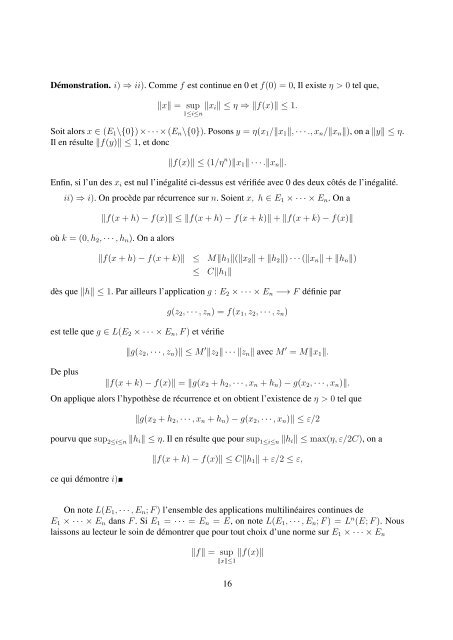LICENCE DE MATHÉMATIQUES FONDAMENTALES Calcul ...
LICENCE DE MATHÉMATIQUES FONDAMENTALES Calcul ...
LICENCE DE MATHÉMATIQUES FONDAMENTALES Calcul ...
Create successful ePaper yourself
Turn your PDF publications into a flip-book with our unique Google optimized e-Paper software.
Démonstration. i) ⇒ ii). Comme f est continue en 0 et f(0) = 0, Il existe η > 0 tel que,<br />
‖x‖ = sup ‖x i ‖ ≤ η ⇒ ‖f(x)‖ ≤ 1.<br />
1≤i≤n<br />
Soit alors x ∈ (E 1 \{0}) × · · · × (E n \{0}). Posons y = η(x 1 /‖x 1 ‖, · · · ., x n /‖x n ‖), on a ‖y‖ ≤ η.<br />
Il en résulte ‖f(y)‖ ≤ 1, et donc<br />
‖f(x)‖ ≤ (1/η n )‖x 1 ‖ · · · .‖x n ‖.<br />
Enfin, si l’un des x i est nul l’inégalité ci-dessus est vérifiée avec 0 des deux côtés de l’inégalité.<br />
ii) ⇒ i). On procède par récurrence sur n. Soient x, h ∈ E 1 × · · · × E n . On a<br />
‖f(x + h) − f(x)‖ ≤ ‖f(x + h) − f(x + k)‖ + ‖f(x + k) − f(x)‖<br />
où k = (0, h 2 , · · · , h n ). On a alors<br />
‖f(x + h) − f(x + k)‖ ≤ M‖h 1 ‖(‖x 2 ‖ + ‖h 2 ‖) · · · (‖x n ‖ + ‖h n ‖)<br />
≤<br />
C‖h 1 ‖<br />
dès que ‖h‖ ≤ 1. Par ailleurs l’application g : E 2 × · · · × E n −→ F définie par<br />
est telle que g ∈ L(E 2 × · · · × E n , F ) et vérifie<br />
g(z 2 , · · · , z n ) = f(x 1 , z 2 , · · · , z n )<br />
‖g(z 2 , · · · , z n )‖ ≤ M ′ ‖z 2 ‖ · · · ‖z n ‖ avec M ′ = M‖x 1 ‖.<br />
De plus<br />
‖f(x + k) − f(x)‖ = ‖g(x 2 + h 2 , · · · , x n + h n ) − g(x 2 , · · · , x n )‖.<br />
On applique alors l’hypothèse de récurrence et on obtient l’existence de η > 0 tel que<br />
‖g(x 2 + h 2 , · · · , x n + h n ) − g(x 2 , · · · , x n )‖ ≤ ε/2<br />
pourvu que sup 2≤i≤n ‖h i ‖ ≤ η. Il en résulte que pour sup 1≤i≤n ‖h i ‖ ≤ max(η, ε/2C), on a<br />
‖f(x + h) − f(x)‖ ≤ C‖h 1 ‖ + ε/2 ≤ ε,<br />
ce qui démontre i).<br />
On note L(E 1 , · · · , E n ; F ) l’ensemble des applications multilinéaires continues de<br />
E 1 × · · · × E n dans F . Si E 1 = · · · = E n = E, on note L(E 1 , · · · , E n ; F ) = L n (E; F ). Nous<br />
laissons au lecteur le soin de démontrer que pour tout choix d’une norme sur E 1 × · · · × E n<br />
‖f‖ = sup ‖f(x)‖<br />
‖x‖≤1<br />
16

















